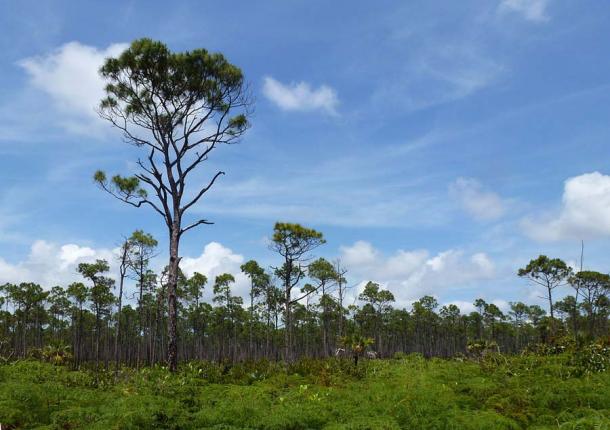
Pre-Columbian Explorers Settled the Bahamas Earlier Than Thought
New evidence suggests that the Bahamas were settled earlier than previously thought. But that’s not all. It appears that the first explorers to arrive on the islands transformed the entire landscape, rapidly.
The Lucayan people were the original settlers of the Bahamas before the European conquest of the Americas in the late 15th century, after Columbus’s arrival in 1492 AD. It was always maintained that they arrived on the islands about 1,000 years ago. Now, new evidence suggests Lucayan explorers arrived in the northern Bahamas about 830 AD.

Map showing the key locations used for understanding the Lucayan migration patterns throughout the Bahamas. (Fall, P. et. al. / PNAS)
The Evidence Lay in Pyrogenic Pine Remains
Until this new research project, it was generally accepted that the Bahamas were not colonized until about 1,000 years ago. Dr. Peter van Hengstum is an associate professor in the Department of Marine and Coastal Environment Science at Texas A&M-Galveston and his recent findings were published in PNAS (Proceedings of the National Academy of Sciences). The team say that soon after 830 AD the Lucayan people expanded rapidly throughout the Bahamas, “in less than 100 years.”
- DNA Studies Reveals True Origins of First Inhabitants of the Caribbean
- Conch Bar Caves: The Largest Non-Submerged Cave System of the Caribbean
The Abaco Islands lie in the northern Bahamas about 180 miles off the coast of southern Florida. The team discovered evidence that soon after the Lucayan people arrived around 830 AD they started burning forests. “Reptiles were extirpated and pyrogenic pine forests took over this island,” according to the new paper. The new findings essentially prove that the island group was colonized 200 years earlier than was believed, and that the settlers changed the landscape, “dramatically.”

The researchers reached their conclusions from evidence gathered at the Blackwood Sinkhole, on the Abaco Islands in the Bahamas. (Fall, P. et. al. / PNAS)
Quick and Dramatic Transformation of the Bahamas
Pete J van Hengstum and his team of researchers drew their new environmental conclusions from evidence gathered at the Blackwood Sinkhole, which they explained in the paper holds near-perfectly preserved organic materials from the last 3,000 years. Using core samples and radiocarbon dating, the team examined charcoal deposits from human fires that they say dated to “thousands of years ago," according to PNAS. This information helped them to determine that the first settlers arrived in the Bahamas much earlier than previously thought.
Hengstum explained that the oldest archaeological sites in the southernmost Bahamian archipelago are found on the Turks and Caicos Islands and these indicate human arrival around 700 AD. Previous evidence suggested it may have taken hundreds of years for the Lucayans to move through the Bahamian archipelago that spans about 500 miles (894 km). Until now, in the northern Bahamian Great Abaco Island, the earliest physical evidence of human occupation are two skeletons from the Abaco sinkhole dating from 1200 to 1300 AD. But the new study changes that belief.

Pine trees at Lucayan National Park in the Bahamas. (Mike Gifford / CC BY-SA 2.0)
Tree Pollen Reveals Historic Hurricanes
The new paper provides evidence of island wide “landscape disturbance” including slash-and-burn agriculture that burned remains indicate began around 830 AD. Slash-and-burn agriculture is a farming method that adopts the cutting and burning of plants in a woodland to create fields for the growing of crops.
- DNA Study Rewrites Caribbean Population History
- Scientists Suggest Columbus' Caribbean Cannibals Might Be True
Further to evidence of slash-and-burning, when the first Lucayans arrived on Great Abaco Island it was mostly covered with pine and palm forests with “a unique reptile-dominated ecosystem of giant tortoises and crocodiles.” The scientists concluded that rapid deforestation and woodland burning allowed pine trees to colonize and this lead to them “out-competing” native palms and hardwoods. The reptiles began to disappear to a great extent after 1000 AD. This means the Lucayans rapidly migrated through the Bahamian archipelago in less than a century, which according the paper represents “just a few human generations.“
Pollen analysis indicated that a significant increase in regional hurricane activity around 1500 AD damaged these new pine forests. The researchers wrote that “compounded perturbations, including forecasts of future hurricane intensification, may continue to alter Bahamian ecosystems, particularly pine forests, which are less resilient than pre-contact tropical hardwood ecosystems.”
In a release by Texas A & M University, Hengstum explained that "the pre-contact forest was not significantly impacted earlier in the record during known times when intense hurricane strike events were more frequent."
Top image: New research suggests that the Bahamas were settled earlier than previously thought. Source: The Grand Turk Museum
By Ashley Cowie















